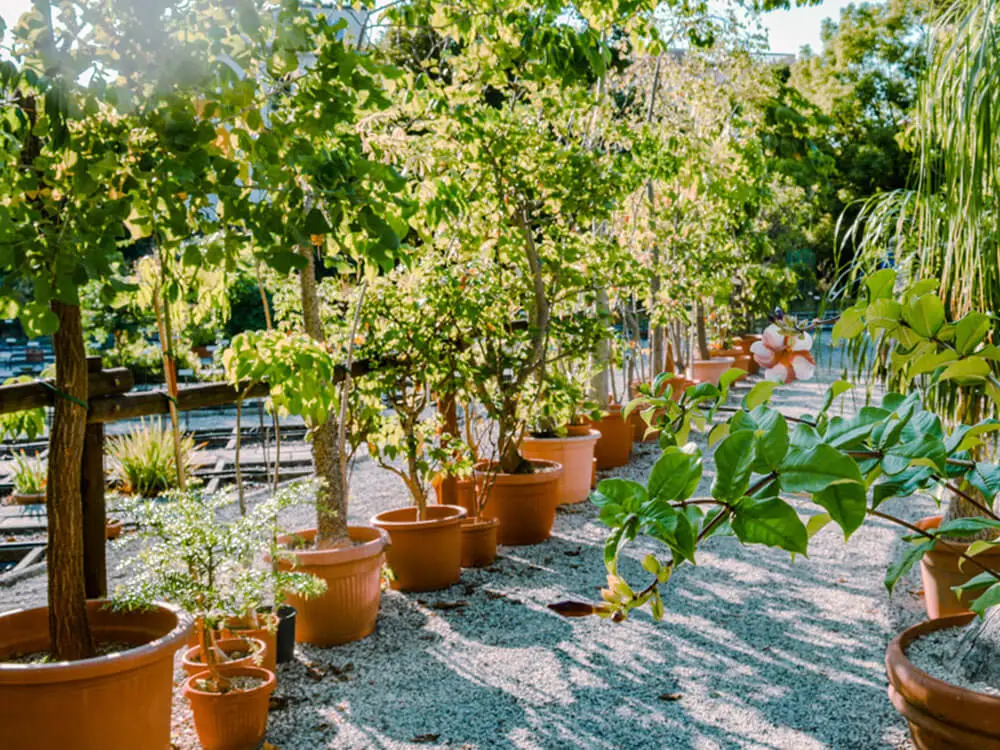8 Essential Tips for Growing Trees in Containers
September, 2022 |Growing trees in containers is an amazing way to bring height, shade, and other benefits into a garden with limited space. It also allows you to mix things up and move them around!
However, trees are not usually used to being bound by a container, so there are some additional steps you can do to make sure they’re as healthy as possible.
Here are 8 essential tips for growing trees in containers and pots in your small garden space.
1. Choose the right container
A container size of 50+ liters and up is usually ideal for most trees. Smaller pots could be used for young, small, or slow-growing varieties, like dwarf conifers or olive trees. Some examples of containers you could use include a trash can (usually 90 liters), large plastic planters, or plastic handled tubs — which make repositioning or moving the tree so much easier.
If you’re placing a tree on a balcony, a plastic, lightweight container will be best to keep the weight down and it also makes it easier to move. Stone, clay, and terracotta pots are often more decorative and will provide stability, but they may not be suitable for balcony gardens.

2. Choose the right tree variety
Some trees aren’t well suited to growing in containers. Their roots might not be able to handle being constricted in a pot. However usually it depends on how big you’re able to let a tree grow. A balcony may not be suitable for a 2-meter cherry tree in a 90-liter pot, for example, so check the maximum height of your desired tree, and how fast it grows.
Usually, small, slow-growing trees are best suited to growing in containers, however with a little patience, you could get almost any tree to grow in a container. Olives, lemons, and apples are all great fruit trees that grow well in containers.
If you have a balcony, check out our list of trees that are suitable for container growing on a balcony. You can easily prune trees to keep them at your ideal height if they start to overwhelm your space.

3. Fill the container with the right soil
Whether you bought a small tree from a nursery or you’re starting a seed yourself, make sure you choose suitable soil. Most compost brands offer a tree and shrub compost bag, but you might also choose your own homemade compost. Remember you can even create compost on a balcony too.
Instead of filling your chosen container to the top with compost or soil, leave roughly 10 inches at the top. This will give you space to add in nutrient-rich fertilizers like manure and seaweed, and also a layer of mulch.

4. Add mulch
Adding a layer of mulch to the top of the container, like wood chips, grass clippings, or dry leaves, helps moisture stay inside. This stops the soil in the container from drying out and potentially damaging the roots or killing the tree.

5. Refresh the top soil layer every spring
It’s usually best to add good, organic fertilizer each spring, just before the trees start growing quickly and sending out new shoots. Make sure you don’t add too much at once as the potency of the chemicals could damage the roots.

6. Add supports or protection
If your small garden is visited by grazing deer you may need to protect the bark of your new container trees. You could use a tree guard to keep the vulnerable bark safe from animals.
You could also add a post or wooden support to stabilize the trunk of the tree as it grows. This can help to keep it straight and also protect it from high winds.
7. Water them regularly
Trees need lots of moisture to keep them healthy and happy, so make sure you keep the soil moist (but not water-logged). In large 90+ liter containers, you’ll need to add in at least 18 liters of water to really soak the soil. Give the container a good soak every 1-2 weeks throughout spring and summer. In the fall and throughout winter (depending on your area) you’ll need to water them a lot less if at all.
If you have lots of trees in containers you might consider adding a water tank or rain barrel to catch excess rainwater.

8. Use additional fertilizer throughout the summer
Spring and summer are the primary seasons for tree growth. Trees will be sending out new shoots and maybe even producing flowers and fruit, so give them a nutritious boost by adding organic fertilizer. You might water them with liquid feed or mix in some dry feed mixes onto the soil at the top. Do this every 2-3 weeks to ensure they have plenty of nutrients.
If you’re growing fruit trees check out our guide to growing fruit trees in containers for tips on choosing the best varieties and seasonal care.





